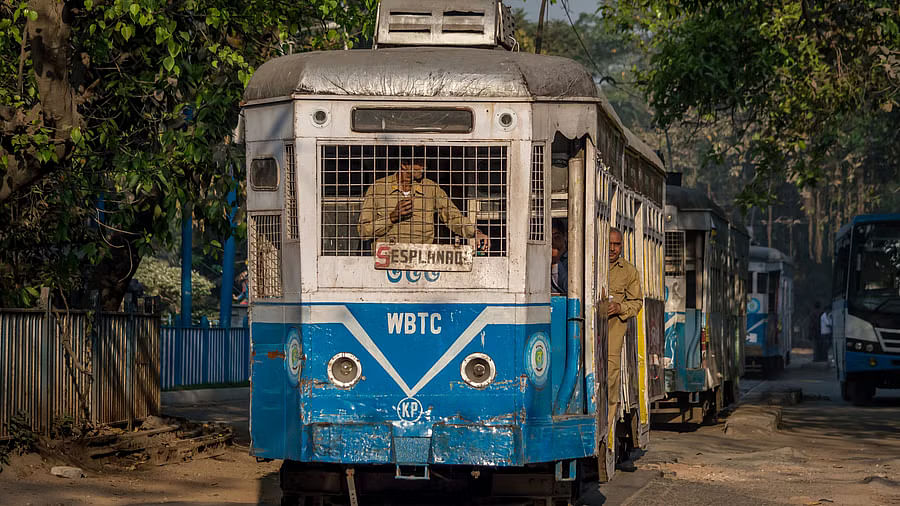
Representative image showing a Tram in Kolkata.
Credit: iStock Photo
Kolkata: Although trams have become a "white elephant" for the West Bengal government, immediate suspension of services is not on the cards as projected in a section of the media, a senior transport official said.
Protests have erupted in Kolkata after Transport Minister Snehasis Chakraborty last week announced that the state government was in favour of discontinuing the 151-year-old tram services from most roads of the city, barring a two-km stretch from Maidan to Esplanade, due to traffic snarls caused by the "slow-moving vehicles".
He, however, added that the matter is sub judice before the Calcutta High Court and the state would make its submission on why it wants the services withdrawn during the course of hearing.
Speaking to PTI on condition of anonymity, the transport official said that the matter was broached by the minister informally at a press conference in response to a query and since the matter is sub judice, no policy decision has been taken so far, contrary to what is being projected by a section of media.
"Tram services are continuing along three routes in Kolkata and we have no plans for immediate withdrawal of these services. However, only 27 tram cars are plying along 12 km at present, down from around 100 tram cars plying along 61 km in 2011.
"The dwindling numbers are due to the fact that once a tram car breaks down, there is no way we can repair it for want of spare parts. Tram cars are turning into white elephants but we are still not in the mood of withdrawing the services altogether. We only wish to rationalise the services keeping in mind the ground situation," he said.
He said from 70,000 in 2011, the number of people commuting in trams daily has come down to 5,000-7,000 at present.
"This is the reason the state has done away with investing in trams since 2018 barring the heritage vehicles which are also used for tourism. We have no intention to withdraw trams meant for heritage purposes," the official added.
Trams were introduced from Sealdah to Armenian Ghat via Dalhousie Square in Kolkata on February 24, 1873 as horse drawn carriages. The trams were modernised with steam-powered engines in 1882, while the first electric-powered tram was introduced in 1900, according to available records.
From the early 20th century, trams became a part of the city's landscape and a popular mode of transportation for middle and lower-middle class residents. The iconic symbol of the city has been featured in Indian cinema since the 1950s.
Trams were so important for the city residents that one paisa hike in its fare in 1953 led to protests spearheaded by communists against the then Congress government in West Bengal.
The recent announcement by the state transport minister also evoked similar response from Kolkata's tram lovers, who described the state government's proposal to discontinue services from most routes as a move to wipe out an integral part of the city's heritage.
The Calcutta Tram Users Association (CTUA) held protests at Shyambazar on Saturday against the proposal.
Similar protests are lined up at Rajabazar and Esplanade tram depots in the days ahead.
"We will not allow this to happen. Trams are here to stay," Shounak Chatterjee, a CTUA member, told PTI during a recent protest at Shyambazar depot in the northern part of the metropolis.
CTUA general secretary Mahadeb Shi said, "At the time of global warming, they are killing an environment friendly mode of transport which has existing infrastructure in the city and only needs to be modernised and contemporised." "With regard to the state government’s argument that trams are causing traffic jams, I would request the minister to go for a reality check. If among 10 lakh vehicles, only 10-20 are trams, how can these cause traffic jams? "While the average vehicular speed in the city is around 20-30 kmph, a tram can pick up a speed of up to 40 kmph. Hence the question of trams slowing down traffic does not arise," he said.
CTUA president Debashis Bhattacharya said that trams are an inseparable iconic symbol of Kolkata like the Victoria Memorial, Howrah Bridge, Coffee House, yellow taxis, wall graffiti, and the football clubs Mohun Bagan and East Bengal.
CTUA has mooted several proposals, including a public-private partnership model to revive trams, but there has not been much response from the state transport department so far, he alleged.